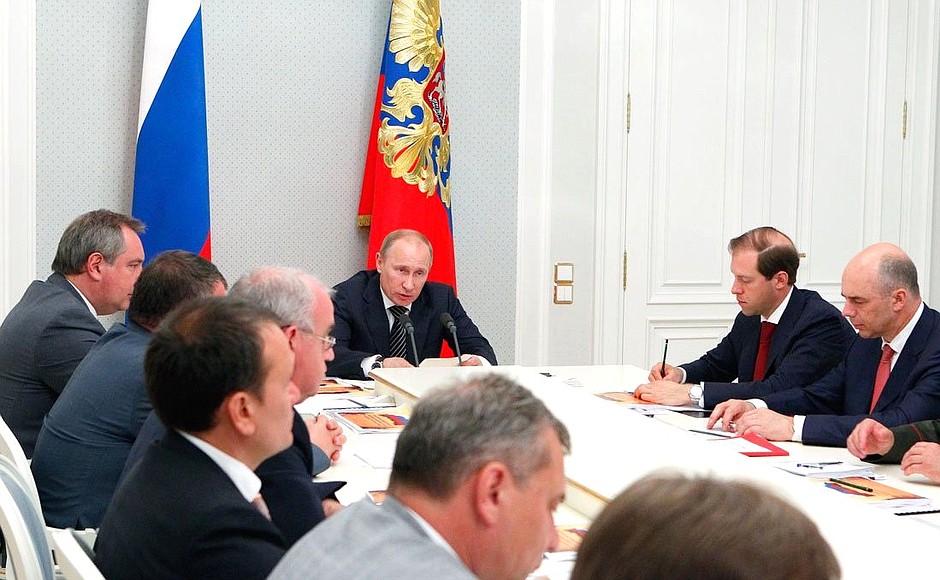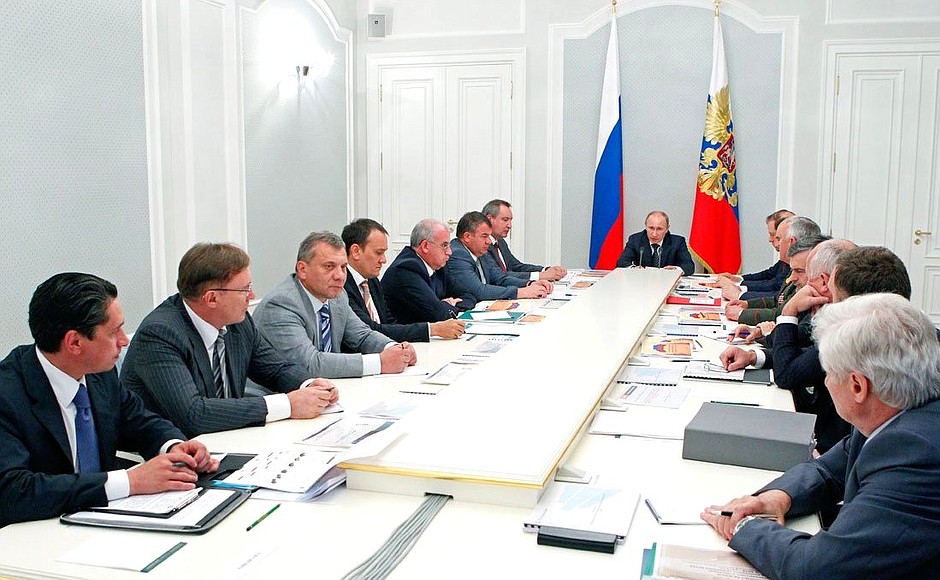Vladimir Putin continues the series of meetings on the implementation of the state armament programme. The first meeting, held on June 14, 2012, was devoted to the supply of aviation systems for the Army and Navy.
* * *
President of Russia Vladimir Putin: Good afternoon, colleagues,
As I announced recently, we will hold a series of meetings and discussions on the implementation of the state armament programme. We need to see how much progress has been made in each area of activity, and the state of cooperation between the customers and the main producers of military equipment.
We have already analysed the situation with the supply of aviation systems for the Army and Navy. Today we will hold a detailed discussion on the supply of modern weapons and equipment to the Land Forces and Airborne Troops.
They play a key role in ground operations, in addressing tasks related to the defence of the state border, the neutralisation of possible local conflicts, as well as participation in peacekeeping operations.
The main requirements for the Land Forces and Airborne Troops today include the ability to operate effectively as part of multi-service forces, their high mobility and combat readiness.
Nearly all the leading countries in the world are increasingly focusing on capacity building of their land forces and airborne troops, as well as other rapid reaction units. New intelligence and control systems, precision complexes and modern armoured vehicles are being actively put into service.
Clearly, we must bear all of these trends in mind and emphasise relevant aspects in our defence planning.
The state armament programme through to 2020 stipulates that more than 2.6 trillion rubles [about $80 billion] are to be allocated for equipping the Land Forces and Airborne Troops. These funds will be used to reequip the troops and to fully satisfy their needs for new equipment. By 2020, the share of new equipment should be at least 70%.
Thus, only the Land Forces are to receive ten Iskander-M missile systems, nine S-300V4 air defence missile systems, over 2,300 tanks, about 2,000 self-propelled artillery systems and weapons, and over 30,000 units of automotive vehicles.
In addition, it is planned to deliver new communications and command systems, cutting-edge intelligence systems and individual equipment.
I want to draw your attention to the fact that all weapons and equipment orders must be completed in full, on time and at the prices agreed, which is very important.
Now I would like to focus on some specific tasks and issues of concern.
See also
First. It is essential to ensure a balanced and comprehensive development of weapons systems. Military equipment is a complex product. Its manufacture involves dozens, and sometimes even hundreds, of subcontractors. Any failure or delay in the execution of a contract may derail the entire process.
For example, the latest artillery equipment cannot be delivered to the troops if the ammunition, optics, the guidance system or intelligence equipment are not in place already.
As an illustration, let us consider the situation with airborne fighting vehicles. They have not passed the state tests and, accordingly, have not been accepted for service. In turn, this hinders the development of almost all armament subsystems for the Airborne Troops.
I would like to hear today why the development and delivery of armoured vehicles for the Airborne Troops as part of the state armament programme has not been completed.
Another example: the creation of a unified tactical level command and control system. The prototype does not fully meet the Defence Ministry’s specified requirements. I would like to hear how this problem is being addressed.
Next. An important area of work I want to highlight is laying the groundwork for the future.
At present, the research and development funding for the Land Forces amounts to less than 10% of the cost of production orders and repairs, and less than 5% for Airborne Troops.
At the same time more than 75% of the total funding accounts for only five research areas. This is an obvious imbalance. It looks like a number of important directions in weapons and military equipment development are severely underfunded.
Please note that we need new solutions for equipping servicemen, for small arms, individual body armour and communication equipment. I would like research and development in these areas to be stepped up.
Third. I will focus separately on the development and delivery of ammunition.
The Defence Ministry and the defence industry must be clear with regard to the current contracts, as well as the future orders, which may be even more important today.
The absence of long-term plans in this field hinders modernisation of the ammunition sector and related industries, including military chemistry and the development and manufacture of ammunition samples for new weapons systems.
We have repeatedly discussed this issue. I believe the time has come for us to decide on the mode of interaction between the Defence Ministry and ammunition companies.
I am aware of the types and quantities of ammunition currently held in stock, but we have repeatedly stressed the need to look to the future. If we do not plan for the future now, at least in terms of general parameters, then we will have no future at all.
Let’s move on to our discussion.
<…>

